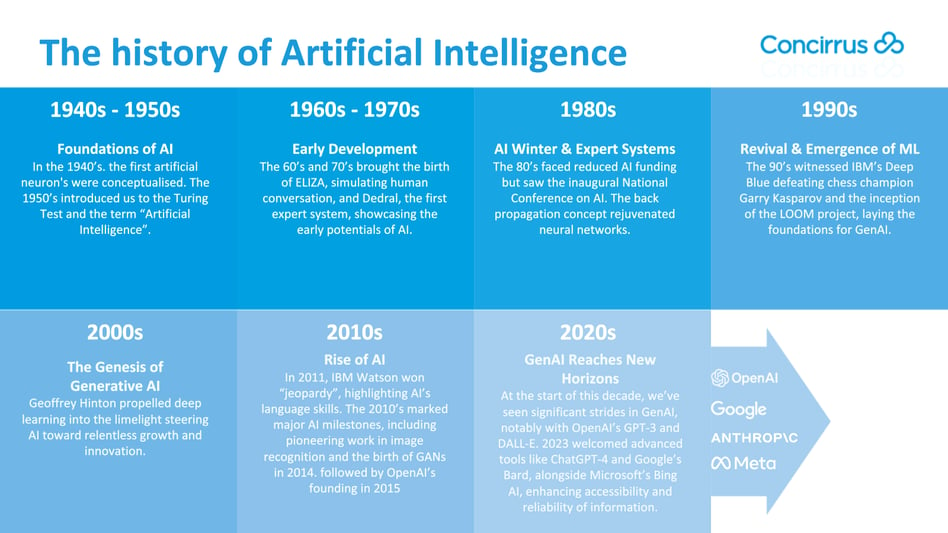Last month, the Concirrus team hosted our annual executive roundtable. Topics including bridging the cargo data gap, and conflict in the Red Sea and Ukraine were addressed. However there was one topic in particular which we could not ignore: AI.
Artificial Intelligence is becoming a popular topic and quickly becoming part of everyday life. But what is it and what should we be looking for when selecting an AI product/service?
So what is AI? Artificial Intelligence (more commonly known as "AI") is not a particular technology. It is a general term for technologies that enable computers and machines to simulate human intelligence and problem-solving.
Our Product Director of Data & Analytics, James Whitlam, explained to the industry leaders that in the last 12-18 months, there has been an explosion of talk of AI, but this does not necessarily mean AI is new. See the below history of AI over the last 80 years.

In the marine insurance market, one of the huge changes have been the volume of available data. James Whitlam said "a lot of AI is about training a model on historical datasets, whether it is the entire internet like OpenAI and Google, or policy and claims data companies like Concirrus use to build models. It all requires data."
AI today
Now in the 2020s, we have seen technology heavyweights like OpenAI, Google and Meta develop these models like GPT-3 and GPT-4, Gemini and Meta AI. This has fundamentally changed the way we can use this type of technology, due to it being so much more accessible. Making AI more accessible has allowed these providers to have a set of API services which any tech company, like Concirrus, can plug into and build into systems.
The Concirrus team explained to the roundtable attendees that they have been focusing their efforts on staying up to date with latest technologies. On thing we have learned is the optimum AI solution is constantly changing. In a matter of weeks or months there will be a new solution or model with a different angle of model accuracy, performance, accessibility etc.
We regularly assess the below:
Problem suitability. What may have been suitable for a model 6 months ago may not be today. We also need to determine if AI is the right solution for the problem at hand, as it will not solve everything.
Security and privacy. This is a significant topic to take note of. We need to ensure this technology is deployed in a safe and useful way. Ensuring the AI solution meets security standards and safeguards sensitive data.
Model performance. Understanding which of these vendors are actually pushing model performance improvement forward with each release, enabling us to maximise value derived from the services we have developed.
Scalability and performance. There are free solutions in the market, but if you are looking to deploy this on a commercial scale, what does that mean in terms of scalability. Consider the ability to handle increased user-interactions.
Integration and compatibility. Ensure the AI model can seamlessly integrate with your existing systems. End points are now readily available, which means any platform can quickly plug in and leverage the technology's value.
Adopting AI is really about creating a flexible technology layer that addresses key AI development risks and future proofs approach to develop those products.
During the roundtable event, discussion continued on how Concirrus keeps the Quest platform as independent as possible from the AI layers sitting behind the UI. We have built a provider-agnostic AI layer with endpoints and guardrails. All concerns around data security, data governance and AI hallucination safeguards are now controlled in that layer which is completely independent of any provider. So when, for example, Google releases a new version of Gemini, we can continue to plug into the platform with no disruption, fitting the changing world around the product/service. This is critical to be able to leverage this technology going forward and having that true nature of actually what you can utilise.
Predictive vs Generative AI
Generative AI is the focus of tech news, but solid business use cases have to-date been driven by Predictive AI. The media is fixated on using ChatGPT for homework and pictures of astronauts riding horses on the moon, whereas in the background, Predictive AI has discovered new drugs and brought them into production.
What's the difference? asked some attendees. Generative AI produces new content e.g. composing marketing emails to customers, while predictive AI analyses existing data e.g. given historical weather data, it will predict today's weather. Additionally Generative AI often uses unsupervised or semi-supervised learning, while predictive AI relies on supervised learning.

Powering the future of insurance
If you want to book a 1-1 meeting with us then let us know by clicking the link below.
Book a meeting